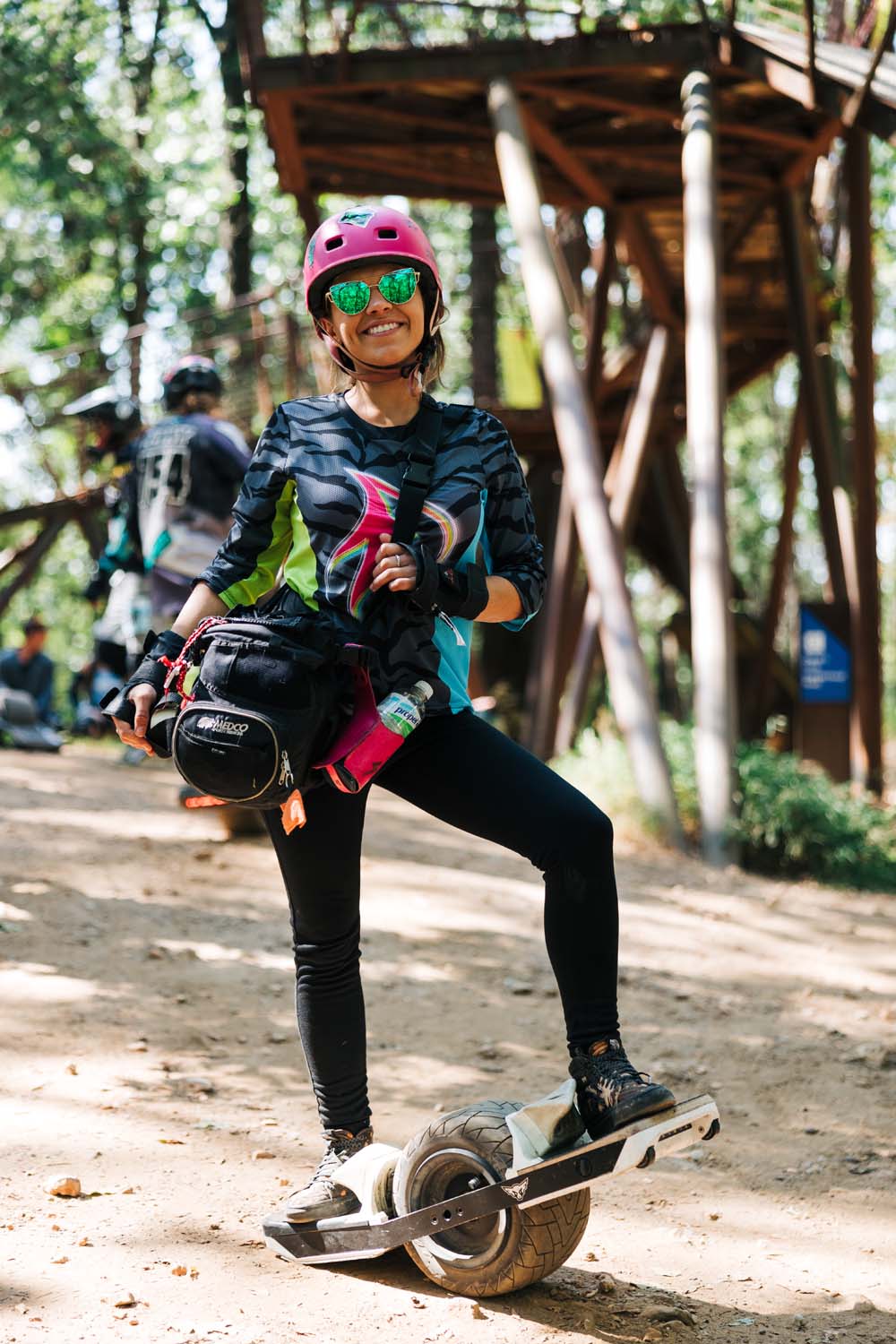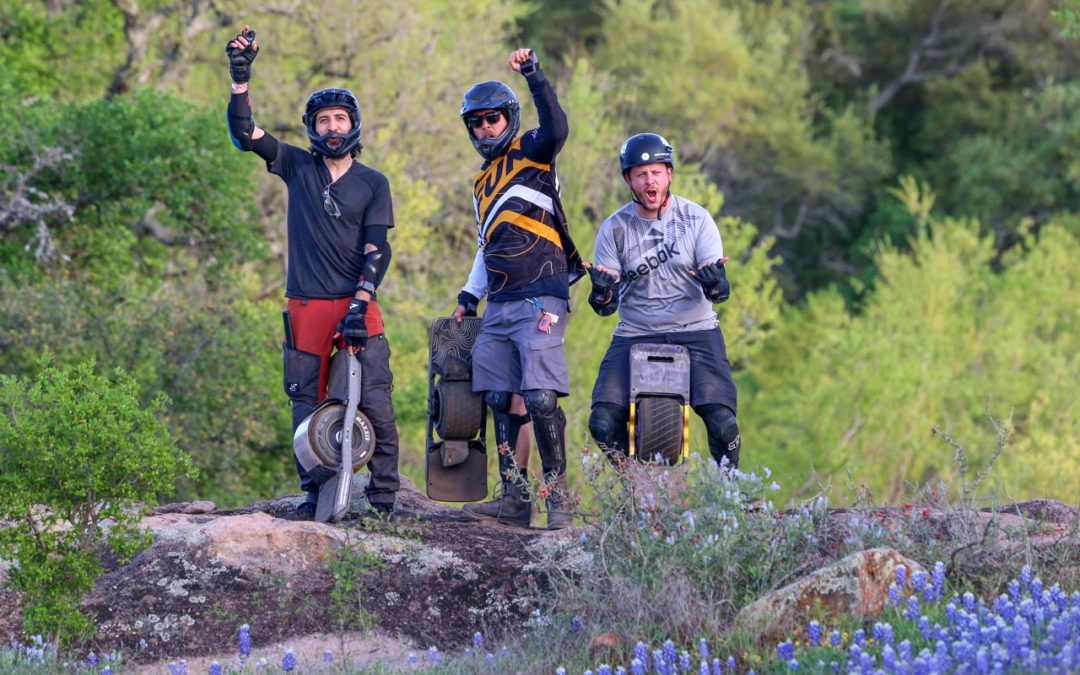Featured photo by Cory Boehne
See more from Armor-Dilloz
It’s spring, and you know what that means: Warmer weather, drier trails, and the return of onewheel events big and small. But wait! Before you roll out, make sure you’re wearing the right protection. If you think you don’t need protective gear—or at least a helmet—keep reading.
IOWA had the opportunity to chat with Heather Wrench, a nationally certified and licensed athletic trainer with a degree in emergency sports medicine. Translation: She’s the one who runs out onto the field after an athlete takes a hard hit and assesses whether it’s safe for them to continue playing.
Heather has volunteered her medical expertise at onewheel events such as Drift Sisters, DirtSurferz, and Floatlife Fest. For this article, Heather filled us in on all the really good reasons we should all join the brain bucket brigade.

I love helping helping athletes succeed at what they love to do and helping protect them when they don’t know how to protect themselves.
Photo by Luke Wein
See more from Carve Creative
Should I wear a helmet on a onewheel?
Some riders think that onewheeling is less dangerous than other board sports because you could, for example, snowboard way faster. But risk isn’t just about speed. Speed may increase the likelihood of a severe injury, but onewheel crashes and nosedives can happen at any speed and in any situation… and they can affect veteran riders just as much as beginners.
A rider does not have to be pushing the board to its limits for an unexpected bike, dog, or child to dart out in front of them. Obstacles like potholes and roots can send even the most skilled riders for a spill. And unlike other board sports, onewheel is not just about the rider’s ability and reflexes; the board itself is an electronic device that can fail with or without warning.
Even if you don’t want to wear protective gear for your own sake, it’s good manners to wear it when riding with others. The Onewheel Racing League and most other onewheel events require a helmet and wrist protection at sanctioned events, and we’ve seen many local groups setting this expectation as well. Nobody wants to be remembered as the guy who ruined the ride by leaving in an ambulance!
Heather’s Words of Wisdom
An accident never happens on purpose. Falls are never planned, but you can plan for them.
What’s the worst that can happen?
Most nosedives involve an impact to the head, Wrench said, even if the head is not the first thing to hit the ground. Speed, momentum, and the weight of your body can still result in a whiplash, head-smacking motion, and you can still get a concussion.
Concussions are traumatic brain injuries (TBIs) that can result in temporary impairment. Full recovery is possible, and easy: All you have to do is rest.
On the flip side, rushing your recovery can put you at even greater risk. A second impact (even a small one) can trigger brain bleeding and sudden death. This is called “second impact syndrome,” and it remains a risk for as long as a person continues to experience concussion symptoms—in some cases, even longer. Therefore, any rider who has hit their head in a crash should be urged to call it a day and begin the process of rest and recovery. Even if they were wearing a helmet.
Whoa, you might be saying; hold up! If helmets don’t prevent brain injuries, then what’s the point?
It’s true that helmets don’t completely eliminate the chance of a head injury, but they drastically reduce how bad it could have been, especially if you slide. The role of a helmet is to mitigate the initial impact by distributing the force. This is accomplished through a combination of padding inside and a hard shell on the outside that enables the helmet to slide on impact instead of sticking/grabbing and risking injury to the neck or spine.
Heather’s Words of Wisdom
Your brain is in charge of all your bodily functions. It controls everything. It’s in a skull, protected by bone, for a reason. Treat it as the most important organ in your body, because it is!
What to do after someone hits their head
Make sure someone who has fallen stays seated for a minute while you assess their condition. The body produces a lot of adrenaline during a crash, so they may not realize they’re injured right away (this goes for non-head injuries, too!).
-
- It is generally best not to move someone who might be injured, but use your judgment: If the fall happened in a high traffic area where they might be at risk of further injury, and if the person can safely move or be moved, you may want to start by getting them out of harm’s way.
- Make sure the person is conscious, breathing normally, and responsive. If not, call 9-1-1 immediately.
- Check for concussion red flags. Pupils of different sizes, confusion, disorientation, slurred speech, headache, brain fog, or personality changes such as heightened emotions are some hallmark symptoms to look out for.
- Ask questions: Do they know where they are, what time it is, what they were doing before they fell? Do they remember the fall itself? While you do this, clean any cuts or scrapes that need cleaning.
- If you suspect a concussion, advise the person to get checked out, and make sure someone at home is monitoring their condition in case symptoms show up later. Contrary to popular belief, you do not need to wake them up every hour. Rest is the best medicine.
The last thing a rider should do after a head impact is get back on their board and keep riding. Even if everything seems to check out, it’s always better safe than sorry with TBIs. Second impact syndrome isn’t worth the risk! Readers, remember this if you’re the one on the ground. Whether it’s your friends on the weekly group ride or medical staff at a racing event, the person advising you to take a break from riding has your health and best interest in mind.
Heather’s Words of Wisdom
People think they can be tough and power through. Your mental strength is not going to save you from this. You can’t just walk it off.
What is the best helmet for onewheel?
A full face helmet offers the best protection, but if that’s too hot, a regular helmet for bicycling, skateboarding or roller skating will still protect your brain better than nothing. Remember: The best helmet for onewheel is the helmet you’ll wear! If you prefer to wear sunglasses or hats, look for a helmet that has goggles or a visor built in, as layering a helmet over your hat (or ponytail or dreadlocks) can impede its effectiveness.
Here are some popular choices for onewheel helmets.
Classic half-lids
-
- Thousand
- xnito
- Bern Watts 2.0
- Bern Macon 2.0
- ProTec certified
- Triple 8 dual certified
- Lumos (good for night riding)
Full-face favorites
Helmet haters always have a reason: It’s too hot or bulky, it doesn’t look cool, it messes up their hair or makes them look like a rookie. But as Heather taught us, it just isn’t worth the risk. Any helmet is better than none! Repeat after me: The best onewheel helmet is the helmet you’ll wear.

